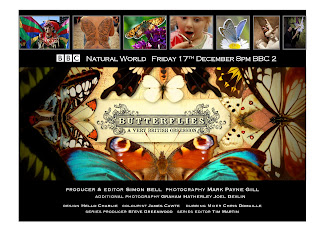
Thursday, November 25, 2010
Chameleon-like
Friday, November 19, 2010
iris on BBC2 - 17th Dec 8pm
BBC2 is to transmit a one hour Natural World programme entitled Butterflies - a very British obsession at 8pm on Fri Dec 17th (not Tues 14th as previously published - they changed it at the last moment).
The grand opening (and of course centrepiece) of the programme is the appearance of His Imperial Majesty, the Purple Emperor, filmed in Straits Inclosure & Goose Green Inclosure, Alice Holt Forest, Hampshire, and Fermyn Woods, Northants, at the zenith of the immortal 2009 iris season (by kind permission of the Forestry Commission and His Imperial Majesty). Hibernating and full grown larvae also appear, and there is a remarkable showdown between Messrs Hulme and Oates. There's also some good side show material, such as the 2009 Painted Lady invasion, Silver-washed Fritillaries courting at Bookham Common, an incredible flight of Heath Fritillary, and cameo appearances by the Mountain Ringlet and Large Blue.
Narrated by Imelda Staunton, the programme is primarily about the cultural significance of butterflies in Britain today. It will be the highlight of your winter - skip the office party, The Messiah, Nine Lessons & Coughing etc., and enjoy!
You heard about it first on this website.
Matthew
Monday, November 15, 2010
Hibernating Larvae
2 Most larvae assume this charcoal grey colour before they come off the leaves. They then match the grey bark well. This larva is in the airport departure lounge.

3 If they settle next to a live bud they change colour to this yellow-green form within about a week.

4 So, this grey larva, which had been in hibernation here for less than a week, should quite quickly turn yellow-green.
I'm only following nine wild larvae in hibernation at present, scattered in several woods. I may find two or three more, but the egg lay was poor (about 1/3rd of 2009's) and the pre hibernation survival rate seems to have been lower than in 09 (I have yet to analyse the data).
Finally brethren, with regard to England's magnificent victory on the rugby pitch on Saturday (which I listed to whilst caterpillaring): why can you never find an Australian when you need one? They simply disappear... .
Wednesday, November 10, 2010
Upper Thames 2010 summary report
1] 2009 was twice as good as any as the previous 6 seasons, but 2010 was even better with 75% more sightings than in 2009. I've no idea why; has anybody?
2] HIM was seen in 46 localities, of which 12 were new habitats, by 45 recorders
3] The best territory was in a very small wood, aptly named Little Wood. Around one huge Ash and several Oaks at the highest point, sightings were made on 15 days between June 28th and August 7th: a 40 day period.
4] The first sightings were on June 28th, and the last on August 8th.
Monday, November 8, 2010
Outrage!
Will the person who deposited a half bottle of Casillero del Diablo in a cleft in a sallow (a female caprea no less) in the Forest of Braydon, north Wiltshire, remove it at once as it is causing considerable offence and may be interfering with the over-wintering of iris.
As those of us of the Second Covenant will know, when The Almighty performed his inaugural miracle he did not turn the water into an insult to wine (as above) but into at the very least a good ordinary claret.
Meanwhile, iris has mostly wandered off into hibernation (three out of 20 larvae were still on leaves yesterday). Unfortunately, the larvae seem to have been stimulated by unseasonally warm weather into wandering a long way prior to settling down, and are therefore going to be extremely hard to find in hibernation this winter. With only a small sample size to start with, the one thing I needed this autumn was cold weather at the start of November, to prevent larvae from moving far from their feeding leaves. A miracle is needed to retrieve the situation.
M


